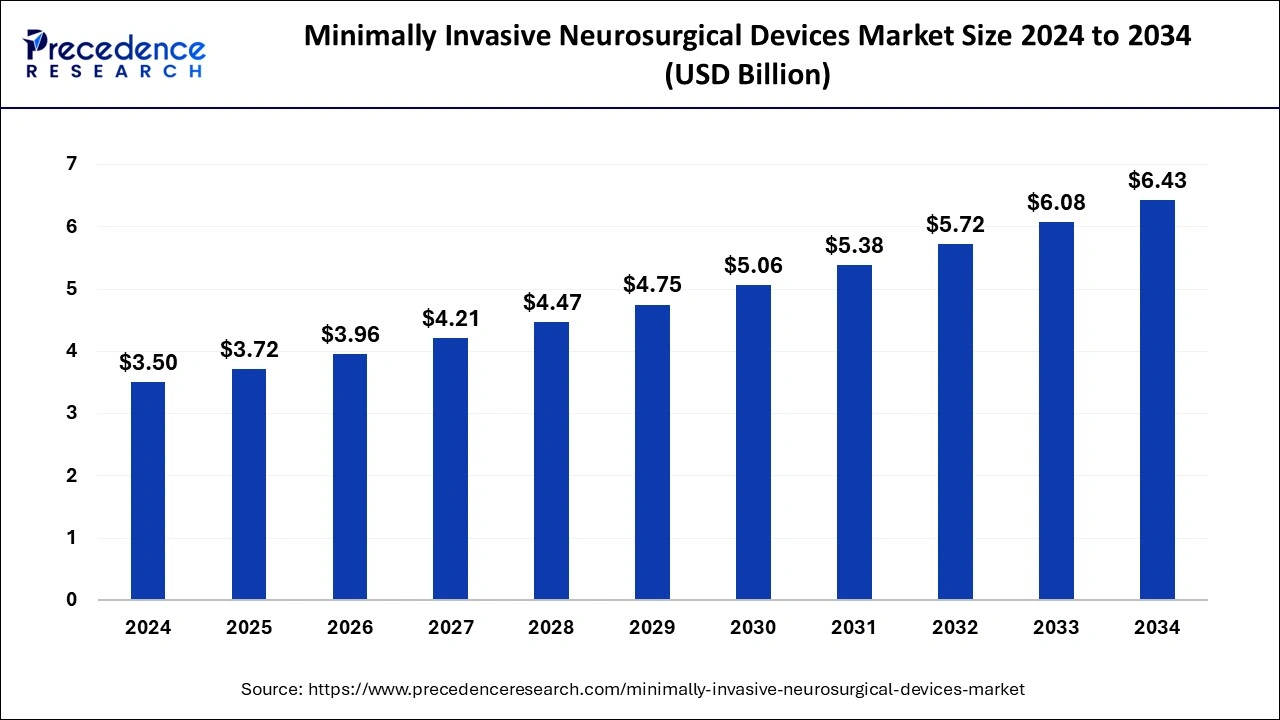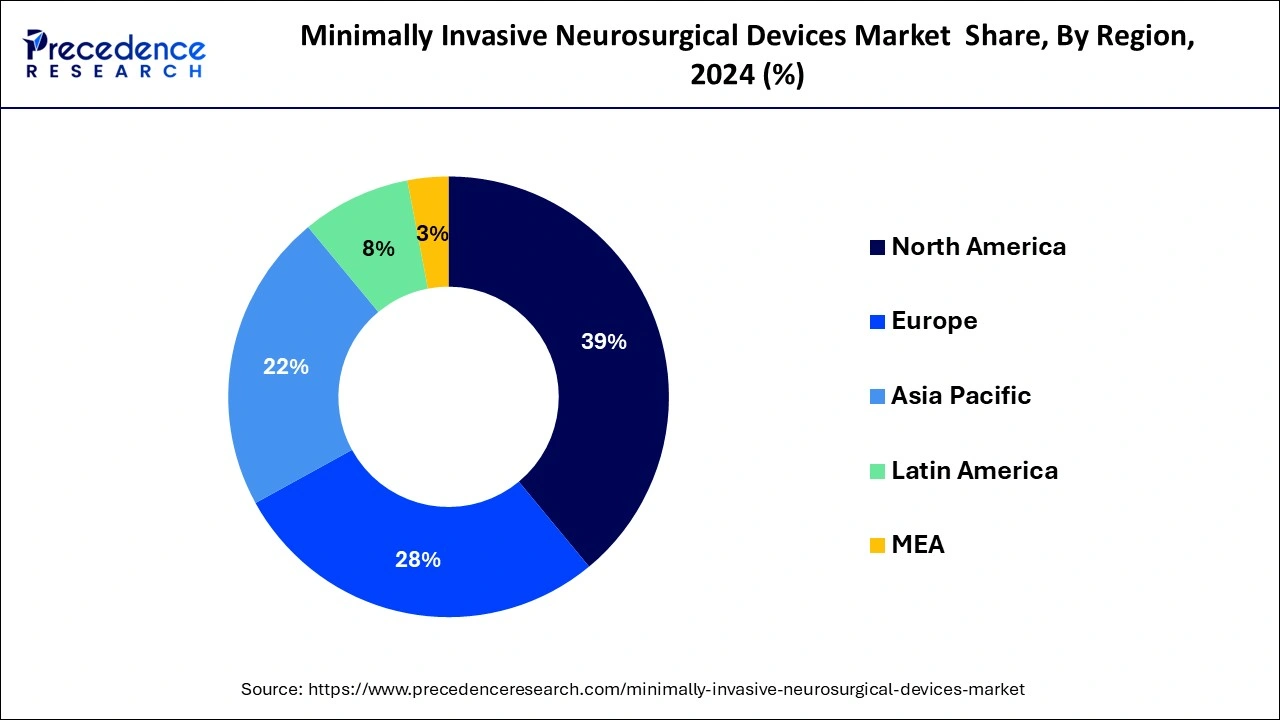List of Contents
Minimally Invasive Neurosurgical Devices Market Size and Growth 2025 to 2034
The global minimally invasive neurosurgical devices market size was estimated at USD 3.50 billion in 2024 and is predicted to increase from USD 3.72 billion in 2025 to approximately USD 6.43 billion by 2034, expanding at a CAGR of 6.27% from 2025 to 2034. The primary reasons behind the growth of the minimally invasive neurosurgical devices market are a rapid increase in the prevalence of neurological conditions and a need for developing safe and less invasive methods of neurosurgery to increase survival rates and enhanced recovery percentages.

Minimally Invasive Neurosurgical Devices Market Key Takeaways
- The global minimally invasive neurosurgical devices market was valued at USD 3.50 billion in 2024.
- It is projected to reach USD 6.43 billion by 2034.
- The market is expected to grow at a CAGR of 6.27% from 2025 to 2034.
- North America dominated the market with the largest revenue share of 39% in 2024.
- Asia Pacific will witness the fastest growth in the upcoming years.
- By type, the spinal surgery segment dominated the market in 2024.
- By type, the intracranial segment is expected to witness significant growth in the market during the projected period.
- By application, the hospital segment dominated the market in 2024.
U.S.Minimally Invasive Neurosurgical Devices Market Size and Growth 2025 to 2034
The U.S. minimally invasive neurosurgical devices market size was estimated at USD 1.09 billion in 2024 and is predicted to be worth around USD 2.05 billion by 2034 at a CAGR of 6.52% from 2025 to 2034.

North America dominated the minimally invasive neurosurgical devices market in 2024. The market showed dominance primarily because of the rapid technological advancements in neurosurgery with growing neurological conditions. Patients are getting complex neurological disorders and require advanced medical care. With novel technology, North America is making a transition towards more efficient and less invasive surgical procedures with a high precision and survival rate. Image guidance and neuromodulation devices are improving in quality and helping in complex surgeries.

Asia Pacific will witness the fastest growth in the global minimally invasive neurosurgical devices market in the upcoming years. With technological advancements, there has been a more enhanced way of understanding the brain's form and function. Hence, doctors can provide more effective treatment to their patients. Neurosurgeries have become easy with more modifications in the equipment and devices. Endoscopic techniques are a significant advancement in the market.
Market Overview
Neurosurgery is much more than brain surgery and comprises the medical specialty involving the diagnosis and treatment of patients undergoing neural health issues. Neurosurgery involves the treatment procedures of the spinal cord and peripheral nerves in the body. These surgeries can be done on all age groups, and different levels of expertise and equipment are used for different age groups. Depending upon the degree of damage, it is decided whether or not to perform surgeries.
Neurosurgeries can be invasive. For example, in cases like a brain tumor, the skull has to be broken, and then the tumor has to be removed. Recovery times in cases of invasive surgeries can be long, and it can be painful as well for the patient. Additionally, the patient might die in such cases. The minimally invasive neurosurgical devices market is primarily driven by this. To decrease the degree of pain after surgery and to increase the chances of survival, it is important to come up with a less invasive method of neurosurgery where the patient would suffer the least.
In the minimally invasive neurosurgical devices market, doctors use natural orifices, like nostrils, to access the lesions or tumors in the brain. The benefit of using the nostrils to access the tumors is that there is no need to make an extra incision in the skull, and there is no scar left. In summary, these surgeries are scar-free, and there are fewer complications. Hence, the patient can also recover faster.
However, in some cases, it is not possible to access the tumors through the nostrils. In such cases, very small incisions have to be made on the skull, and the tumor can be accessed directly. Microsurgical techniques also help in performing large resections with high precision, and they involve less disturbance, similar to surgery involving a natural orifice.
Minimally Invasive Neurosurgical Devices Market Growth Factors
- A shorter postoperative period in services of the minimally invasive neurosurgical devices market is the major benefit offered over the traditional alternatives.
- Improved aesthetic outcomes are observed in the minimally invasive neurosurgical devices market.
- Faster recovery times, along with higher precision, drive the growth of the minimally invasive neurosurgical devices market.
Minimally Invasive Neurosurgical Devices Market Scope
| Report Coverage | Details |
| Growth Rate from 2025 to 2034 | CAGR of 6.27% |
| Market Size in 2025 | USD 3.72 Billion |
| Market Size by 2034 | USD 6.43 Billion |
| Largest Market | North America |
| Base Year | 2024 |
| Forecast Period | 2025 to 2034 |
| Segments Covered | By Type and By Application |
| Regions Covered | North America, Europe, Asia-Pacific, Latin America, and Middle East & Africa |
Market Dynamics
Drivers
Lesser complications
When people hear about neurosurgeries, they think of scary scenarios of cracking open the skull and performing a nasty surgery. In the old days, surgeries used to be this way. They were invasive, and the patients suffered a lot. The success rates of these surgeries were also quite low, and there was a need for less invasive surgeries where the patients suffered less. Many technological advancements have taken place to design more precise and less invasive neurosurgical devices.
The rise in neurological disorders
Brain tumors, epilepsy, Parkinson's, etc., are increasing in prevalence because of a rising geriatric population. The older population has a lower tolerance to pain, and recovery rates are slower as well. Reimbursement policies have improved, and people can afford these surgeries because of good insurance coverage. Patients, too, prefer these surgeries because of less pain and better recovery. More awareness about neural disorders and treatment is driving the minimally invasive neurosurgical devices market forward.
Restraints
High costs
Minimally invasive neurosurgeries require high-quality equipment with better precision. Since these surgeries involve the least damage to the patient, trained experts in this field must perform the surgeries. As the trained experts also charge a lot for these surgeries, the overall cost of the surgeries is high. However, there are fewer costs post-surgery, and it pretty much cancels out the high surgery costs. There is a shortage of trained and skilled professionals, and this might affect patients in rural areas where medical care is not that developed.
Safety testing of the devices
Products of the minimally invasive neurosurgical devices market are required to undergo proper testing and approvals before using for surgeries. The testing procedures can be long and time-consuming, and it might even require a lot of resources. This can impact the minimally invasive neurosurgical devices market growth in a negative manner. Minimally invasive neurosurgical devices also have efficacy concerns in some cases. Sometimes, minimally invasive surgeries cannot be as efficient as open surgeries, and patients might have to go for invasive surgeries.
Opportunity
Developed neural healthcare
The minimally invasive neurosurgical devices market involves advanced imaging and operating techniques. Companies willing to grow in this field have ample opportunities to conduct extensive research and development to produce more affordable equipment and machines. This can bring down the costs of neurosurgeries, and poor people can afford them, too. The government can introduce policies to make these surgeries affordable to the poor masses. These surgeries reduce recovery times, and hence, patients have to spend less time on medicines. The outcomes of these surgeries will be more positive and have fewer failures. Companies can have tie-ups with hospitals for supplying the equipment. This will help hospitals with fewer funds to buy instruments on EMI.
Type Insights
The spinal surgery segment dominated the minimally invasive neurosurgical devices market in 2024. Spine surgery, when done with the traditional approach, the surgeon makes a long cut through the skin, and a large amount of muscle is pulled out to see the surgical site. This results in more pain after the surgery. However, in the case of minimally invasive surgery, incisions of around half an inch are made through the skin. A small metal tube is placed in the incision so that the surgeon can work through the small operative field. Working with smaller incisions causes less damage to muscles and tissues than a single long incision. The benefits of this surgery are that it requires less time to recover, fewer scars are visible on the body as compared to one large scar by traditional surgery, and the patient needs to take fewer medications.
The intracranial segment is expected to witness significant growth in the minimally invasive neurosurgical devices market during the projected period. There is a need to do intracranial surgeries in cases like brain tumors or hemorrhages. Brain abnormalities are treated within the brain and surrounding areas. The brain is the most important part of our body as it controls each and every movement in our body, voluntary or involuntary. Brain surgeries relieve the pressure on the brain caused by blood or cerebrospinal fluid.
Application Insights
The hospital segment dominated the minimally invasive neurosurgical devices market in 2024. This is because hospitals have developed infrastructure, advanced facilities for imaging, better operating rooms, and better neurosurgical equipment. Hospitals have highly trained professional surgeons to conduct minimally invasive neurosurgeries. Hospitals offer complete patient care, which includes the surgery and post-surgery monitoring of the patient. Hospitals have high-quality facilities for operating and taking care of patients.
Minimally Invasive Neurosurgical Devices Market Companies
- Karl Storz
- Olympus
- Conmed
- Richard Wolf
- Boston Scientific
- Integra LifeSciences
- Aesculap
- Smith & Nephew
- Medtronic
- NICO Corp
Recent Developments
- In April 2024, Dr Reddy's launched a drug-free, noninvasive device to manage migraines. The device is named Nerivio. Nerivio is supported by Dr. Reddy's patient support program, which is M-free. The program is a comprehensive support system that will enhance the journey of patients. The services will include onboarding and counseling of patients, device demonstrations, doorstep delivery, flexible payment options, informative content, and dedicated customer care service.
Segments Covered in the Report
By Type
- Intracranial Surgery
- Endonasal Neurosurgery
- Spinal Surgery
By Application
- Hospitals
- Clinics
- Others
By Geography
- North America
- Asia Pacific
- Europe
- Latin America
- Middle East & Africa
For inquiries regarding discounts, bulk purchases, or customization requests, please contact us at sales@precedenceresearch.com
Frequently Asked Questions
Ask For Sample
No cookie-cutter, only authentic analysis – take the 1st step to become a Precedence Research client